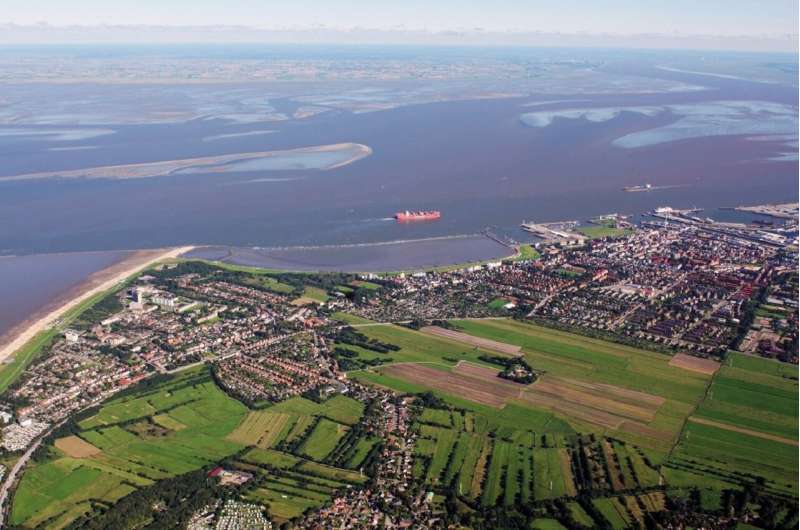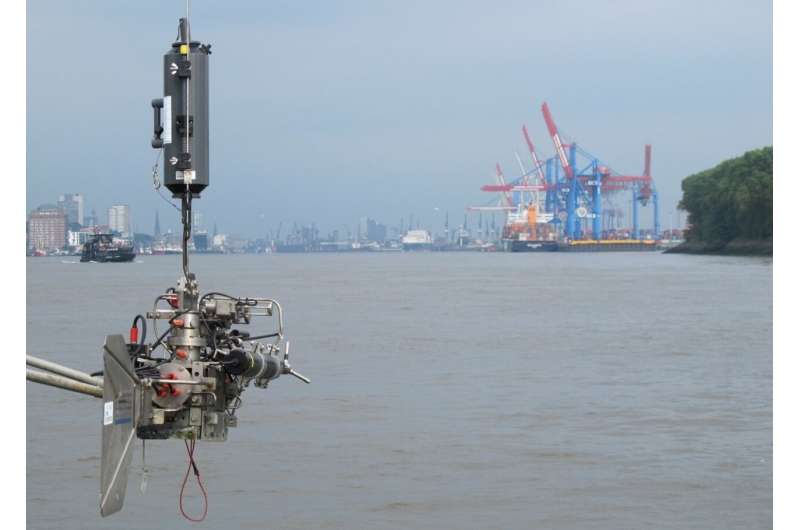This article has been reviewed according to Science X's editorial process and policies. Editors have highlighted the following attributes while ensuring the content's credibility:
fact-checked
peer-reviewed publication
trusted source
proofread
Estuaries as climate gas hotspots

Nitrous oxide has a much stronger effect on the climate than carbon dioxide. Soils, peatlands and rivers are potential nitrous oxide sources. However, when, where and how much nitrous oxide is emitted into the air has not yet been sufficiently researched.
A team led by Gesa Schulz, a doctoral student at the Helmholtz-Zentrum Hereon, has now studied nitrous oxide production in the Elbe estuary in greater detail and discovered real hotspots. The results, which were recently published in the journal Biogeosciences, can help to better assess the sources of nitrous oxide worldwide.
When it comes to climate change, most people talk about the greenhouse gas carbon dioxide, which is released in large quantities through the combustion of natural gas, crude oil and coal. What is often overlooked is that there are other potent greenhouse gases that have been far less researched. These include nitrous oxide (N2O) in particular, whose effect on the climate is almost 300 times greater than that of carbon dioxide.
N2O is released primarily by biological processes and the decomposition of nitrogen compounds in agriculture, but rivers or peatlands can also emit nitrous oxide. However, where, when and how much nitrous oxide escapes into the atmosphere worldwide is still unclear. The Intergovernmental Panel on Climate Change estimates that 1% of the nitrogen that enters rivers rises into the air as nitrous oxide after biochemical conversion. But these are rough estimates.
Too much nitrogen from agriculture
A team led by Gesa Schulz, a doctoral student at the Helmholtz-Zentrum Hereon, has therefore taken a closer look and measured nitrous oxide production in the entire Elbe estuary from Geesthacht, east of Hamburg, to the North Sea over several years and in different seasons. As the scientists write in their paper, the Elbe estuary releases nitrous oxide throughout the year—although the amount varies from season to season. In addition, nitrous oxide production differs from river section to river section.
"Our data show that the main source of nitrous oxide production is agriculture, which applies nitrogen," says Schulz. "Especially in winter, when plants are not growing and hardly consume any nitrogen, a lot of nitrogen enters the river with the rain and melting snow."
Biochemical and microbial processes then convert some of the nitrogen to nitrous oxide. These processes do not occur as quickly in cold water as they do in summer. However, strong storms often stir up and mix the water of the Elbe during the winter, releasing a comparatively large amount of nitrous oxide into the atmosphere at this time of year.
Schulz and her colleagues have also discovered that there are two nitrous oxide hotspots in the Elbe estuary: The port of Hamburg releases a particularly large amount of nitrous oxide. In addition, there is the estuary section from Cuxhaven to Brunsbüttel, where the Elbe water strongly mixes with water from the North Sea at high tide. This section of the Elbe is known as the "maximum turbidity zone" (MTZ).

Algae blooms produce nitrous oxide
Nitrous oxide production in the MTZ is caused by microalgae that grow in the nearshore North Sea in spring and summer. These are transported upstream into the MTZ at high tide. When the algae die, they are microbially and biochemically decomposed, releasing a lot of nitrous oxide.
In the Port of Hamburg, the situation is somewhat different. In spring and summer, the Elbe transports large amounts of freshwater algae downstream to the Port of Hamburg, which were able to grow mainly due to the nitrogen introduced by agriculture. Since the Elbe in the port of Hamburg is dredged to about 15 meters for the large cargo ships, the algae suddenly pass from the light-flooded upper reaches of the Elbe into deep dark water, where they die. This makes a lot of biomass available for biochemical decomposition, which consumes a lot of oxygen, favoring the production of nitrous oxide. Accordingly, nitrous oxide production is high there in summer.
Finding solutions together
Together with social scientists from the University of Hamburg, Schulz is working in the Hamburg Cluster of Excellence "Climate, Climatic Change and Society" (CLICCS) to improve the situation and, in coordination with various institutions from the Elbe region and the Hamburg Port Authority, to find new ways of sustainable management.
"We want to find out what measures can be taken to reduce nitrogen input into the Elbe and the production of nitrous oxide in the river," she stated. Later, farmers along the Elbe will also be involved to find solutions that can actually be implemented on a day-to-day basis.
In addition, the data that Schulz and her colleagues have collected are very important for a fundamentally better assessment of nitrous oxide production in estuaries. For the last decades, measurements in the atmosphere and the estimates of the Intergovernmental Panel on Climate Change show a continuous increase of N2O emissions. However, the N2O sources have not yet been identified or accurately measured.
"We are contributing to answering these open questions," says Schulz. "This also makes it possible to address the problem regionally through targeted measures." Her research may also help to better calculate nitrous oxide emissions in computer climate models in the future.
More information: Gesa Schulz et al, Seasonal variability of nitrous oxide concentrations and emissions in a temperate estuary, Biogeosciences (2023). DOI: 10.5194/bg-20-3229-2023
Journal information: Biogeosciences
Provided by Helmholtz Association of German Research Centres




















